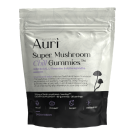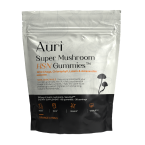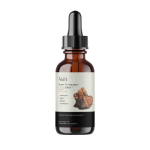Unveiling the Mysteries: Mushroom Fruiting Body vs. Mycelium

Have you ever wondered how mushrooms spring up overnight? This marvel starts deep below the surface with the unseen yet vital role of mycelium—the vegetative part of a fungus.
However, it is the fruiting body that ultimately provides the powerful health benefits found in functional mushroom supplements.
Mycelium forms an intricate network beneath the soil, absorbing nutrients and preparing for the growth of what we see and admire: the mushroom fruiting body.
The mushroom mycelium vs fruiting body debate encapsulates a fundamental aspect of fungal life cycles, highlighting the distinct yet interconnected roles each plays.
From the extensive underground networks of mycelium to the emergence of the whole mushroom fruiting body, these growth stages are pivotal phases in the ecological contributions and biological functions of the mushroom as a whole.
Exploring Mycelium
Mycelium is the vegetative part of a fungus. This means it is the part of the fungus that grows and absorbs nutrients, forming the structure from which mushrooms develop. It consists of a network of fine white filaments called hyphae.
Mycelium thrives beneath the soil or within its host, supporting the fungus's growth and aiding in the absorption of nutrients from the environment.
Let's dive into some of its remarkable characteristics and functions:
Nutrient Recycling
Mycelium breaks down organic materials, releasing essential nutrients back into the soil. This enriches the soil for better plant growth, sustaining ecosystem health and diversity.
Symbiotic Relationships
Mycelium forms mutualistic associations with plants, enhancing water and nutrient absorption. These relationships improve plant health and soil quality. It showcases the vital ecological role of mycelium.
Biodegradation
Mycelium is capable of decomposing complex organic compounds, contributing to environmental clean-up. It thrives in moist, nutrient-rich environments. Its preferred habitats vary widely, from rotting wood to rich soil, playing a pivotal role in almost any terrestrial ecosystem.
In nature’s ecosystem, mycelium is a powerhouse. It acts as a natural recycler, breaking down dead material and replenishing the earth. This function supports diverse life forms, maintaining ecological balance.
Understanding Mushroom Fruiting Body
The mushroom fruiting body is the reproductive structure that emerges from the mycelium, typically visible above ground. These structures are often umbrella-shaped, comprising a stalk and a cap, sometimes adorned with gills or pores beneath the cap.
The life cycle of these fruiting bodies begins when environmental conditions trigger their development from the mycelium. They mature, release spores, and eventually decompose, completing their life cycle and spreading spores to give rise to new mycelial colonies.
When discussing the unique compounds found in mushroom fruiting bodies, like the immune-boosting polysaccharides in Chaga, the nerve-supporting erinacines in Lion’s Mane, and the energy-enhancing cordycepin in Cordyceps, it's worth noting how Auri’s products are designed to maximize these elements for your health benefit.
Several factors influence the development of mushroom fruit bodies. These factors include:
- Humidity and Temperature: Specific levels are required for different species. For example, Turkey Tail mushrooms thrive in temperatures between 18 to 24 degrees Celsius with moderate humidity levels. Lion's Mane mushrooms, on the other hand, thrive in cooler conditions, preferring temperatures between 15 to 21 degrees Celsius with high humidity.
- Light: Adequate light triggers and supports the development of fruiting bodies. Different species require varying light intensities; for instance, Maitake mushrooms need indirect light to form properly, enhancing their growth and spore dispersal.
- Nutrient Availability: Rich substrates often yield more prolific fruiting. The type of substrate—such as hardwood for Lion's Mane mushrooms—significantly impacts the quality and quantity of the mushroom harvest.
These factors collectively determine the successful development of the mushroom's fruiting body.
Moreover, the diversity in fruiting body morphology is vast. This reflects the ecological adaptations and evolutionary history of each species.
From tiny, intricate forms to large, robust structures, each type of mushroom fruit body exhibits unique characteristics. This diversity enhances the ecological formation and the variety of mushroom powder products derived from different mycelium and fruiting bodies.
Intriguingly, the role of fruiting bodies extends to medicinal applications like immune support and cognitive health, making them a key component in mushroom supplements. Understanding their natural benefits can enhance our appreciation and utilization of these fungi.
Comparative Analysis: Mushroom Mycelium vs. Fruiting Body
Understanding the differences between mushroom mycelium and fruiting bodies enriches our appreciation of the mushroom life cycle.
These components play distinct yet interconnected roles in the growth and reproduction of fungi, including species like the reishi mushroom.
|
Aspect |
Mushroom Mycelium |
Mushroom Fruiting Body |
|
Physical Attributes |
Consists of a network of hyphae, usually hidden from view. |
The visible part of the mushroom which typically includes a stalk and cap. |
|
Biological Functions |
Absorbs nutrients, supports growth, and forms the foundation for fruiting bodies. |
Reproduces by releasing spores, completing the life cycle. |
|
Environmental Adaptations |
Thrives in dark, moist environments. Pure mycelium can adapt to various substrates. |
Requires specific conditions of light, temperature, and humidity to develop. |
Now, let’s explore the relationship dynamics in fungal development. The mycelium forms the essential support system, creating the structure from which the fruiting body can emerge.
This interplay is critical; without the mycelium’s nutrient-gathering capabilities, the fruiting bodies could not develop or spread spores.
Both stages are crucial for the propagation and survival of fungi, highlighting how mushroom powders, derived from different stages, can vary in composition and benefits. This synergy is key to understanding how beneficial compounds are developed throughout the mushroom's life cycle.
At Auri, we use the mushroom fruiting body for its rich concentration of bioactive compounds, ensuring maximum health benefits. Curious about the difference Auri Nutrition mushroom products can make? See the results for yourself
The Significance of Mycelium
Mycelium, the underground part of mushrooms, plays a fundamental role in the natural world and various industries. Its ability to decompose organic matter makes it a cornerstone of ecosystem health and sustainability.
This process supports soil fertility and biodiversity, acting as nature’s recycler.
Commercial Applications
The versatility of mycelium extends into numerous industries:
- Biodegradable Packaging: Mycelium-based materials are used to create eco-friendly packaging solutions.
- Building Materials: It's employed in the manufacture of sustainable building products that are strong yet lightweight.
- Agriculture: Mycelium is used in biocontrol to protect crops from pests and diseases naturally.
Medical Implications and Research Usage
Mycelium is a research focal point due to its potential in medicine. Scientists explore its capacity to produce bioactive compounds that could lead to breakthroughs in health treatments. These active compounds are studied for their roles in boosting immunity and combating diseases.
Culinary and Nutritional Value
In the culinary world, mycelium contributes to the texture and flavor of functional mushrooms.
Nutritionally, it is rich in vitamins and minerals, offering a variety of beneficial compounds that support health. Its role in creating mushroom-based products highlights its value both in kitchens and dietary supplements.
The Enigma of Fruiting Bodies
Mushroom fruiting bodies offer numerous health benefits, such as boosting the immune system, providing antioxidant properties, and supporting cognitive health.
For example, Reishi mushrooms contain polysaccharides and triterpenoids, which have immune-modulating and anti-inflammatory effects. Cordyceps are known for enhancing energy levels and athletic performance due to compounds like cordycepin.
Additionally, Turkey Tail mushrooms contain polysaccharopeptide that support immune function and gut health.
These biological advantages make fruiting bodies essential in producing mushroom extracts and medicinal mushrooms.
Auri Nutrition has pioneered the development of edible mushroom gummies. Our gummies are crafted to harness the health benefits of various mushroom fruiting bodies, providing you with an easy and delicious way to incorporate these powerful compounds into your daily routine.
The economic impact of fruiting bodies is profound. They are key in producing mushroom extracts and medicinal mushrooms, which are essential in pharmaceuticals and nutraceuticals.
The cultivation of high-demand species like reishi and cordyceps has become a significant agricultural sector, providing income for thousands and driving advancements in biotechnology.
Conservation Efforts and Challenges
Conservation of mushroom fruiting bodies faces challenges such as habitat loss and overharvesting.
Efforts to sustain them include regulated harvesting, habitat restoration, and the establishment of protected areas to preserve mushroom habitats. These strategies help to maintain the biodiversity and ecological roles of mushrooms.
Delving into Mutual Exclusivity: Key Differences
Fruiting bodies and mycelium differ fundamentally in their roles within the reproductive processes of fungi. The fruiting body is the reproductive structure. It is involved in spore dispersal, while mycelium serves as the vegetative growth phase for nutrient absorption and support.
Mycelium consists of a complex network of hyphae that spread extensively underground or within decaying organic material.
In contrast, fruiting body mushrooms develop above ground, visible and often striking in form, marking a later stage in the fungal life cycle.
Their growth patterns reflect these roles; mycelium expands horizontally to colonize new areas, whereas fruiting bodies grow vertically with a focus on spore release.
Survival Strategies
Mycelium and fruiting bodies deploy unique survival strategies to thrive in competitive environments.
Mycelium can remain dormant under adverse conditions, springing back to life when conditions improve.
Fruiting bodies, however, often have shorter lifespans; they must quickly mature, release spores, and ensure the continuation of the mushroom species before decomposing. This ephemeral nature requires precise timing, maximizing spore spread during optimal environmental conditions.
Exploring Fungal Influence and Uses
The environmental impact of mushrooms extends beyond simple ecology. These organisms play crucial roles in nutrient cycling and soil health, fundamentally sustaining plant life and biodiversity.
Their interactions with other fungi and plant roots can either support or compete within their ecosystems, highlighting a complex web of relationships.
Human Utilization and Technological Implications
Mushrooms have been harnessed by humans for centuries, not only as food but also for medicinal purposes.
Today, the use of mushroom supplements and fruiting body extracts is prominent in alternative medicine, offering potential health benefits from immune support to cognitive enhancement.
On the technological front, advancements in biotechnology have leveraged fungal properties for everything from bioremediation to creating sustainable building materials. This symbiosis between fungi and technology continues to grow, driven by the ecological efficiency and versatility of mushrooms.
The integration of fungi into our environmental, health, and technological spheres underscores their significance.
As we continue to explore and utilize these organisms, their comprehensive impact only becomes more apparent, promising further innovations and solutions in various fields.
Experience the benefits of Auri Nutrition’s mushroom products, crafted to support your overall wellness. Try them now!
Bringing Clarity to the Fungal Frontier
Throughout this blog post, we've explored the distinct roles of mycelium and fruiting bodies within the fungal kingdom. Both components are essential to the life cycle and ecological contributions of fungi.
Mushroom fruiting bodies offer numerous health benefits, such as boosting the immune system and supporting cognitive health. These benefits make them a key component in high-quality mushroom supplements.
Ready to experience the health-enhancing benefits of mushroom fruiting bodies?
Discover how Auri Nutrition’s products maximize these powerful compounds. Visit our shop today and find the perfect blend to boost your wellness journey.










